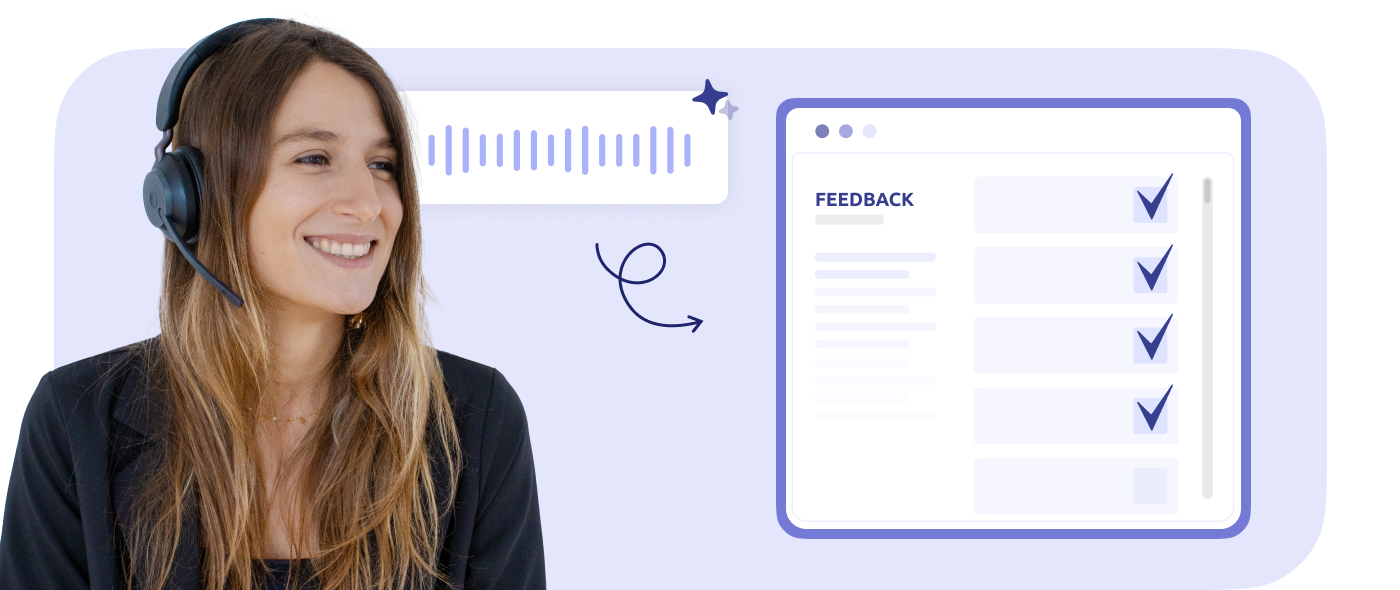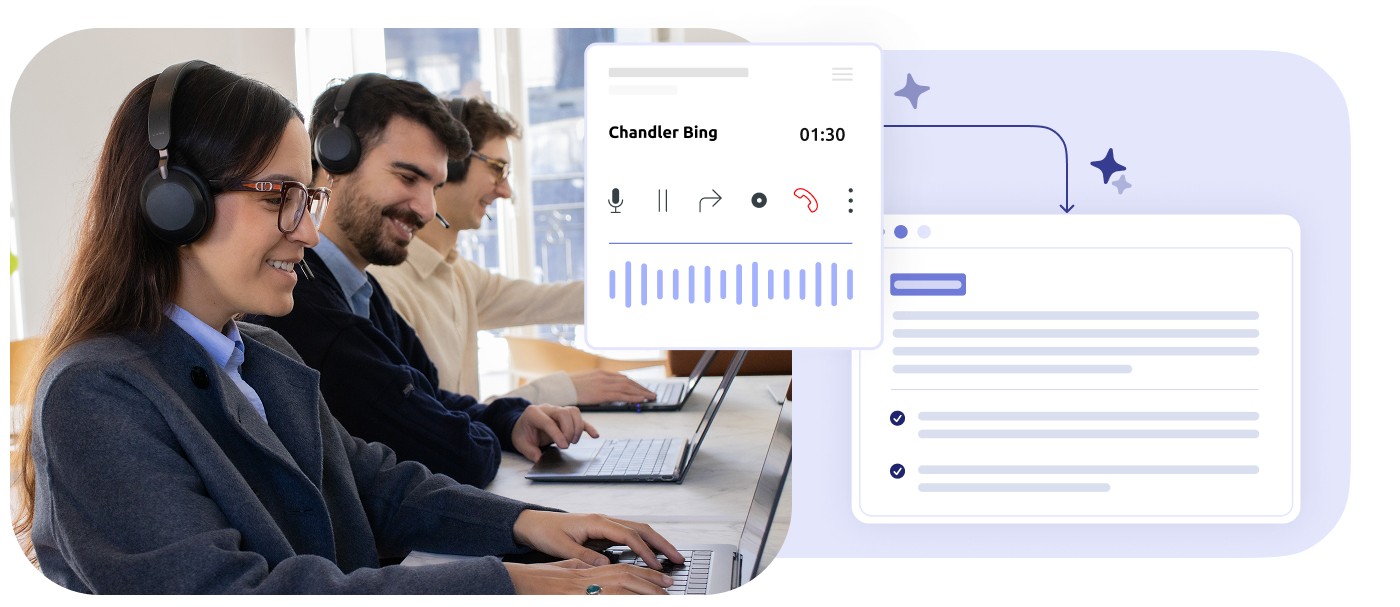A training model that is out of sync with reality
Static content that doesn’t reflect the real world
Most customer service training programs rely on generic content: playbooks, e-learning modules, call scripts. While these tools are great for sharing basic knowledge at scale, they fall short when agents face edge cases or emotionally charged situations.
Worse, the scenarios used in training are often oversimplified. They rarely represent the wide variety of customer contexts or the emotional and technical depth of actual requests.
So even if call center agents master the basics, they can feel unprepared (or even powerless) when it really counts.
One channel at a time? That’s not how customers think
Another common limitation: training is often split by communication channel. One module for phone, another for chat, a separate one for email.
But in reality, customers don’t follow those rules. They jump between channels mid-conversation.
Agents must be able to follow these non-linear paths. If your customer service training doesn’t reflect that, you risk slower resolution times, inconsistent answers, and frustrated customers.
Want to dive deeper? Check out our article on how to coach your team for a successful omnichannel experience.
Soft skills aren’t enough: product and process knowledge matters
Soft skills are typically front and center in customer service training, and rightly so. But agents also need a solid understanding of the company’s products, services, internal tools, and customer workflows.
When these areas are glossed over, agents struggle to provide accurate answers, especially in technical, regulated, or high-stakes situations.
Ineffective training without a feedback ecosystem

Supervisors have the tools, but often don’t use them
Training doesn’t end after onboarding. Supervisors and quality managers play a critical role in identifying improvement opportunities across the team.
Yet valuable tools like call recordings, conversation summaries, dashboards, and wallboards often go underused.
Instead, feedback is delivered through sporadic audits with little long-term structure.
Without regular feedback, agents miss a key opportunity to improve: learning what went well, and what could’ve been handled better, based on real interactions.
The learning loop is broken
Effective customer service training relies on a cycle of continuous improvement. That means capturing wins and mistakes, sharing them, analyzing them, and translating them into actionable lessons.
But in many teams, that loop simply doesn’t exist.
Mistakes keep repeating. Best practices get lost. Adjustments happen informally (if at all).
And without structured quality monitoring, friction points often go unnoticed. That’s a missed opportunity to raise service quality using your own data.
Real-world feedback rarely makes it into training
Even when you do gather valuable insights, like call reviews, performance evaluations, coaching notes, they rarely feed back into the customer service training process.
This real-world intel should be gold for instructional design, but it often ends up ignored.
Training modules rarely get updated to reflect what’s actually happening in the field.
Which means agents aren’t being exposed to the kinds of situations they’re likely to encounter.
That disconnect between training and lived experience limits the impact of your entire program.
To fix this, feedback must be integrated into training in a structured way:
- Choose real, representative cases
- Simulate scenarios using your actual CRM or CCaaS data
- Add short corrective modules after recurring issues
By grounding customer service training in operational reality, you give agents practical tools that apply immediately.
The cost of poor customer service training
Rising operational costs
When customer service training doesn’t prepare agents to resolve issues on the first try, it shows.
Customers call back. Tickets get escalated. Issues bounce between departments.
That drives up resolution times, increases the cost per interaction, and clogs up your service pipeline.
On a large scale, you could be wasting hundreds of hours per month on problems that better training could’ve prevented in the first place.
Poor training = higher turnover
When agents regularly face situations they don’t feel equipped to handle, it wears them down.
It’s frustrating. It’s stressful. And it often leads to burnout.
This is especially true for new hires, who may lack the tools or support to get over those early hurdles.
That turnover becomes expensive fast. Every departure means more recruiting, more onboarding, more lost time.
Better-aligned customer service training can break that cycle.
Poor training, poor CX
When issues aren’t resolved, customers call again, or worse, they leave.
They might escalate on social media, reach out on multiple channels, or turn to a competitor altogether.
In short: ineffective training doesn’t just hurt your internal ops, it directly impacts customer loyalty and retention.
Smarter training: A data-driven, technology-enabled model

Train using real cases from the field
To be effective, customer service training should be grounded in real-life situations, the kinds agents encounter every day.
The good news? Modern solutions like Diabolocom make this possible thanks to AI-powered features and data integrations.
With tools like call transcription, auto summaries, conversation recording, and quality monitoring, it’s easy to gather real examples and centralize them for training purposes.
These insights can then be turned into modules based on real interactions, not made-up scripts.
The goal isn’t to complicate training. It’s to make it more relevant.
Real-world examples help agents grasp expectations, anticipate objections, and craft better responses.
They also build agent confidence and autonomy when dealing with technical or sensitive topics.
Embed tools into the training experience
CCaaS platforms like Diabolocom offer advanced features like voice recognition, CRM screen pops, and satisfaction analysis.
These tools are now part of an agent’s daily workflow, so they should be part of training, too.
- Simulate interactions using your full tech stack
- Train agents on real-world interfaces
- Teach them how to use live data during calls
When customer service training mirrors the tools and systems agents actually use, performance improves.
Agents save time, respond more accurately, and feel empowered to deliver quality support.
Design an environment that supports learning
Centralize information to support real-time action
Even a well-trained agent can struggle if they’re constantly switching between tools to find the info they need.
That’s why centralizing customer data (conversation history, account status, open cases…) is key.
It simplifies workflows, reduces stress, and boosts agent autonomy.
From a training perspective, it also means making learning materials accessible right where agents work, without disrupting their flow.
Need to check a product sheet? Pull up a tutorial? Double-check a process? That should take seconds.
Foster a culture of micro-feedback
Training shouldn’t be limited to scheduled sessions.
Short, contextual learning bursts, triggered by real events, can reinforce skills in the moment, without slowing things down.
For example:
- A quick reminder after a poorly rated interaction
- A short reinforcement module when recurring errors are flagged
- A suggested response after a tough call
These micro-interventions drive continuous learning, tailored to what’s actually happening on the floor.
Powered by CCaaS data, they help turn customer service training into a constant, agile improvement engine that’s fully aligned with the agent experience.
Conclusion
In today’s fast-paced, omnichannel world, where customer interactions span multiple channels and expectations continue to rise, traditional, one-size-fits-all training just doesn’t cut it anymore. To truly prepare agents for the complexity and pressure of modern customer service, training needs to be smarter, faster, and deeply rooted in real-life data.
That’s where Diabolocom transforms the game. By embedding training into the everyday tools your teams already use, leveraging real-time insights, and supporting continuous improvement, our solution helps customer service teams grow stronger with every interaction. It’s not just about learning—it’s about lasting impact: more confident agents, consistently higher service quality, and customers who feel truly heard and valued.
Optimize your customer service training with Diabolocom



